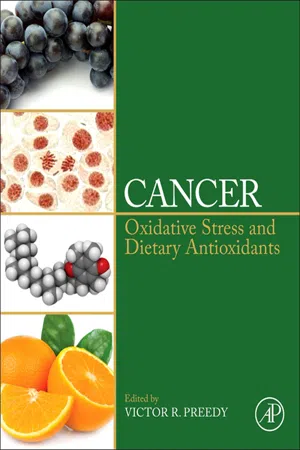
- 308 pages
- English
- ePUB (mobile friendly)
- Available on iOS & Android
About This Book
Cancer: Oxidative Stress and Dietary Antioxidants bridges the trans-disciplinary divide and covers in a single volume the science of oxidative stress in cancer and then the potentially therapeutic usage of natural antioxidants in the diet or food matrix. The processes within the science of oxidative stress are described in concert with other processes such as apoptosis, cell signaling, and receptor mediated responses. This approach recognizes that diseases are often multifactorial and that oxidative stress is a single component of this.
Oncologists, cancer researchers, and nutritionists are separated by divergent skills and professional disciplines that need to be bridged in order to advance preventative as well as treatment strategies. While oncologists and cancer researchers may study the underlying pathogenesis of cancer, they are less likely to be conversant in the science of nutrition and dietetics. On the other hand, nutritionists and dietitians are less conversant with the detailed clinical background and science of oncology. This book addresses this gap and brings each of these disciplines to bear on the processes inherent in the oxidative stress of cancer.
- Nutritionists can apply information related to mitochondrial oxidative stress in one disease to diet-related strategies in another unrelated disease
- Dietitians can prescribe new foods or diets containing anti-oxidants for conditions resistant to conventional pharmacological treatments
- Dietitians, after learning about the basic biology of oxidative stress, will be able to suggest new treatments to their multidisciplinary teams
- Nutritionists and dietitians will gain an understanding of cell signaling, and be able to suggest new preventative or therapeutic strategies with anti-oxidant rich foods
Frequently asked questions
Information
The Role of Oxidative Stress in Breast Cancer
Abstract
Keywords
reactive oxygen species; redox adaptation; antioxidants; superoxide dismutase; apoptosis; estrogen; epigenetics; inflammation; aging; hypoxia| 8-OHdG | 8-Hydroxydeoxyguanosine |
| γ-GCL | Gamma-glutamylcysteine synthetase |
| γ-GCS | Gamma-glutathione synthase |
| Akt | Protein kinase B |
| AP-1 | Activator protein-1 |
| ARE | Antioxidant response element |
| Bax | Bcl-2-associated X protein |
| Bcl-2 | B-cell lymphoma 2 |
| Bcl-xl | B-cell lymphoma-extra large |
| BRCA1 | Breast cancer susceptibility gene 1 |
| BSO | Buthionine sulfoximine |
| CA9 | Carbonic anhydrase IX |
| c-Abl | Abelson murine leukemia viral oncogene homolog |
| CD | Conjugated dienes |
| cFLIP | Cellular FLICE inhibitory protein |
| cIAP | Cellular inhibitor of apoptosis |
| COX2 | Cyclo-oxygenase 2 |
| CYP | Cytochrome P450 |
| CYP1B1 | CYP family 1, subfamily B, polypeptide 1 |
| CYP1A1/2 | CYP family 1, subfamily A, polypeptide 1/2 |
| DNMT | DNA methyltranserase |
| EGFR | Epidermal growth factor receptor |
| eNOS | Endothelial nitric oxide synthases |
| EPO | Erythropoietin |
| ER | Estrogen receptor |
| ERE | Estrogen response elements |
| ERK | Extracellular-signal-regulated kinase |
| GLUT1 | Glucose transporter 1 |
| GPCR | G-protein coupled receptor |
| GPx | Glutathione peroxidase |
| GSH | Glutathione |
| GSK3β | Glycogen synthase kinase 3β |
| GSR | Glutathione reductase |
| GSS | Glutathione synthetase |
| GSSG | Glutathione disulfide |
| GST | Glutathioine S-transferase |
| GSTP | Glutathione-S-transferase P1 |
| HDAC1 | Histone deacetylase 1 |
| HER2 | Human epidermal growth factor receptor 2 |
| HIF-1 | Hypoxia inducible factor 1 |
| HO-1 | Heme oxygenase 1 |
| HRE | Hypoxia response elements |
| IGFBP5 | Insulin-like growth factor-binding protein 5 |
| IHC | Immunohistochemistry |
| IKK | IκB Kinase |
| IL-6 | Interleukin-6 |
| iNOS | Inducible nitric oxide synthases |
| Keap1 | Kelch-like ECH-associated protein 1 |
| LDH-A | Lactate dehydrogenase-A |
| LOH | Loss of heterozygosity |
| LOOH | Lipid hydroperoxides |
| MAPK | Mitogen-activated protein kinase |
| MAPKKK | MAPK kinase kinase |
| MDA | Malondialdehyde |
| MMP | Matrix metalloproteinase |
| mETC | Mitochondrial electron transport chain |
| NDRG1 | N-Myc downstream-regulated 1 |
| NF-κB | Nuclear factor kappa-light-chain-enhancer of activated B cells |
| nNOS | Neuronal nitric oxide synthases |
| NOS | Nitric oxide synthases |
| NQO1 | NADH quinone oxidoreductase 1 |
| Nrf2 | Nuclear factor (erythroid-derived 2)-like 2 |
| NSAID | Nonsteroidal anti-inflammatory drug |
| PGE2 | Prostaglandin 2 |
| PI3K | Phosphatidylinositide 3-kinase |
| PR | Progesterone receptor |
| Prx | Peroxiredoxins |
| PTEN | Phosphatase and tensin homolog |
| Ras | Rat sarcoma protein |
| RNS | Reactive nitrogen species |
| ROS | Reactive oxygen species |
| RTK | Receptor tyrosine kinase |
| SERM | Selective estrogen receptor modulator |
| siRNA | Small interfering RNA |
| Smac(Diablo) | Second mitochondria-derived activator of caspases |
| SOD | Superoxide dismutase |
| Src | Sarcoma protein |
| TAK1 | Transforming growth factor-β activated kinase-1 |
| tBHQ | tert-Butylhydroquinone |
| TERT | Telomerase reverse transcriptase protein |
| TNBC | Triple negative breast cancer |
| TNFα | Tumor necrosis factor α |
| TRAF | TNF receptor associated factor |
| TRAIL | TNF-related apoptosis-inducing ligand |
| Trx | Thioredoxins |
| VEGF | Vascular endothelial growth factor |
| XIAP | X-linked inhibitor of apoptosis protein |
Introduction
Redox Homeostasis: ROS Production and Elimination
Table of contents
- Cover image
- Title page
- Table of Contents
- Copyright
- Preface
- List of Contributors
- Section 1 Oxidative Stress and Cancer
- Section 2 Antioxidants and Cancer
- Index
- Color Plates